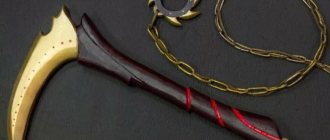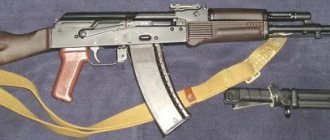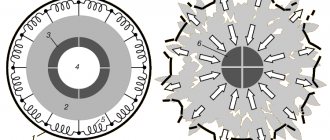The karambit knife is a traditional weapon of the peoples living in the Malay Archipelago. According to two existing versions regarding the shape of the knife blade, it is called a tiger claw, and according to another, it is called a rooster’s paw. During cockfights, which the Malay people love, they put spurs on the bird’s paws, reminiscent of a karambit blade. Therefore, it is impossible to determine exactly what appeared first: the knife or the spurs.
Seeing it for the first time, it may seem like a terrible, deadly device. But in reality everything looks a little different. Depending on their form, they are divided into household and combat types. Even women use it for self-defense; the military uses it when the main weapon is broken or lost. In this case, this adaptation becomes the last chance for survival.
History of origin
The first knives of the karambit type have been known since the 14th century. But there is no reliable information about its origin. The authorship is mainly given to the Minangkbau people, who used these devices during battles with their neighbors over land territories.
They were also needed to solve everyday problems: removing and processing skins, cutting up animal carcasses and fish. They were used to peel vegetables, fruits, cut small branches, etc. Combat and utility types of knives differed in blade size, handle shape, and purpose, of course.
According to other versions, the prototype of modern karambit was:
- Malay agricultural implement sickle.
- Spurs that fit on the paws of a rooster.
- A type of Indian brass knuckle knife.
Where the truth is here is unknown, but the history of the karambit knife concerns the territory of Malaysia, where it is also called the “tiger claw”, because the shape of the blade is very similar to it.
Tiger Claw Bagh Nakh
Let's talk about fighting claws. First on our list is a guest from India, who is popularly nicknamed “tiger claw”. Despite their sinister appearance, these close-combat weapons were primarily used for ceremonial purposes. It was common in the Mysore region of India in the 1700s, where it became an attribute of adherents of the cult of the tiger goddess. This type of brass knuckles consisted of 4-5 pointed curved blades, imitating a tiger paw and attached to a transverse crossbar. In combat, the weapon could tear skin and muscle, leaving long, bleeding cuts, but it was poorly suited for causing lethal damage.
Design and material of manufacture
This knife can truly be called an unusual model invented by mankind. Arouse his interest:
- form;
- grip style;
- possession technique.
The external design of karambit can be described as follows:
- The blade is curved in shape (usually sickle-shaped), dimensions from 5 to 9 cm.
- The blade is sharpened on the inside.
- At the end of the handle there is a ring into which the little finger or index finger is threaded for better grip of the handle with the hand.
- The length of the knife is no more than 20 cm.
Because of the ring on the handle of the knife, it is almost impossible to knock it out of your hands during battle. It prevents your palm from slipping onto the blade and helps you perform a variety of tricks, which are the highlight of combat techniques.
Hold it with a straight or reverse grip. Those who are not familiar with the karambit knife may think that this is a shoemaker’s tool. But in his homeland he is a typical representative of edged weapons.
In ancient times, knives were made from a suitable metal, usually carbon steel. The handles were made:
- leather binding;
- from animal horns;
- hard wood.
The scabbard was wooden, decorated with ornaments, and they followed the curve of the blade. Nowadays, private craftsmen and industrial manufacturers use modern alloys that are of good quality and strength.
Tekken - ninja brass knuckles
Several centuries before the 1868 revolution, there was another specific weapon that may have inspired the impoverished Okinawan nobility to create weapons from stirrups. This is Tekken - the iron hand of the ninja. It was a curved iron strip in the shape of a rectangle with spikes on one side. The tekken could be worn either with its spikes facing outwards or inwards.
The technique of using the tekken depended on how it was put on the hand. If it was worn with spikes inside, it was used to block bladed weapons. By hitting the sword with a tekken in a swing, one could have time to deliver a fatal blow with the main weapon.
If the tekken was dressed with its spikes facing outward, then it was used as the main weapon. The blow from the spikes easily pierced the skull and broke bones.
Distribution across the globe
Nowadays it’s difficult to find a place where they don’t know about the karambit knife. It is widespread in its homeland and in many parts of the world. Its models are being improved, new elements are being added, although this is no longer the classic form of karambit, but this does not lose demand.
The first karambits came to the American continent along with emigrating citizens from Southeast Asia. At that time, few people paid attention to this knife design. The unusual device was not noticed for a long time. But in the 80s of the last century, with the revival of martial arts, interest was shown in him.
Masters of Asian martial arts: Indonesian - Pencak Silat and Filipino - Pekiti-tirsia Kali, showed their skill and technique of using karambit in battle.
After this, many in the West became interested in this knife, which was the beginning of rush demand and the development of the knife industry.
Manufacturers created and combined classic elements of karambit based on other well-known knife models, not forgetting to produce real Malay devices for martial arts practitioners. To use the unique capabilities of karambit, long training is required under the guidance of experienced instructors.
Today, in the catalogs of all well-known knife manufacturers you can find different types of karambit.
Tekko
The Iron Fist of Okinawa was traditionally made of wood and metal. Three blunt pins were usually attached to the crescent that protected the fingers, with which they tried to hit the ribs, collarbones, joints and other vulnerable points.
Tekko-kagi is his close relative, but with a more professional bent. These shinobi weapons have become widespread in popular culture; let us recall, for example, the main antagonist of the Teenage Mutant Ninja Turtles franchise, Shredder. Long (10-30 cm) steel claws really make a strong impression: first of all, they are intimidating weapons, designed for the effect of surprise. However, its combat characteristics are also quite good: with metal strips, pointed at the ends and located in such a way as to effectively protect the owner’s hand, it is quite difficult to inflict lethal wounds. But it’s easy to mutilate an attacker and make him bleed from deep cuts!
The attitude of the law in different countries to the karambit knife
In Russia, according to the Federal Law “On Weapons”, this type of knife is allowed to be freely carried and sold within the country. It is not considered a melee weapon.
Any Russian citizen can purchase karambit without fear of problems with the law.
The knife has been successfully tested in field conditions, police, and military units in many European countries:
- American police officers use this type of knife as an additional weapon. But folding karambit is used by members of the US Marshals Aviation Service, who escort and protect aircraft from terrorist attacks.
- The Malaysian Police Special Unit wears a karambit insignia.
- In Ukraine, this knife is also available for free sale and no special permission is required to purchase it.
A karambit knife and killing a person with it, as criminologists say, is in principle impossible. Unless you hit an artery with a cutting blow.
The technique of using this device was developed based on the use of cutting lunges, which cause painful injuries, damaging tendons, muscles, arteries, and leaving lacerations.
But this applies to the use of a classic-looking knife. And when it exceeds the legal limits, it is no longer a toy, but a life-threatening weapon.
According to modern law, the length of the blade at which any knife is considered a weapon is 180 mm.
Therefore, when choosing a model, you need to be guided by this, so as not to get into a “delicate” situation.
Nowadays, in Europe and other continents, a knife of this shape has found its admirers; fans of computer games fight with them in their battles, and in self-defense schools they teach the art of using it.
Throughout the history of military operations and battles, humanity has come up with hundreds of types of outlandish weapons that make it possible to kill an infidel in some cunning way. Eastern countries have especially succeeded in this matter - from there the authors of fantasy products have drawn, are drawing, and will not draw upon sources of unhealthy fantasy for a long time. In Japan, one such example of an outlandish weapon, but very beloved by romantic souls, was tekko-kagi (or tekkokagi) - ninja fighting claws.
The first analogue of tekko-kagi that comes to mind is Logan's paws from X-Men (Wolverine): long blades protruding from the outside of the palms. If we abstract from this image, then the claws of the shinobi were sharp not along the entire length of the blade, but only at the ends of steel strips attached to the hands with the help of two metal (rarely leather) clamps - at the wrist and like a handle in the palm. These stripes could protrude from 10 to 30 centimeters in length, the width was sufficient to serve as protection for the hands of a shinobi - otherwise the practical meaning of tekko-kagi would be lost. Not without reason, I clarified that these claws (unlike other representatives of the tekaga’s “hand hooks” - shuko) have a distinctly combat aspect - they will not help in any way to climb a wall or a tree.
The tekko-kagi fighting technique, contrary to expectations, is not as diverse as it seems, and comes down mainly to variations of the “block with one hand - attack with the other” combination. Performing fast dances with lightning-fast chopping “mills” is hampered by the considerable weight of the claws (up to several kilograms) and the rather small radius of impact. In addition to the relatively low lethality of the tekko-kagi (this requires reaching quite deeply into the opponent's soft tissue), this paints a slightly sad picture of the prospects for its use.
But for ninjas, the use of tekko-kagi carried a slightly different connotation than its use as a mere weapon. Psychologically, the long, sharp animal claws on the limbs of what at first seemed like a man were very strongly imprinted on the consciousness of the one who encountered an armed tegi, especially if the attacker’s face even resembled a demon escaped from hell. Long, torn and quite deep scratches, if not killing, but hopelessly disfigured the enemy, leaving the horror of the encounter for the rest of his life. For ninjas, long, wide iron strips, instantly controlled by the hands, served as good protection against edged weapons and made it possible to save the lives of shinobi for such valuable seconds in battle.
Hayabusa doesn’t shy away from using tekko-kagi either!
How to make claws from cardboard or plasticine
The claws look impressive when they are made using cardboard rather than ordinary paper.
To make them, you will need the following materials:
- cardboard;
- glue;
- spoke or rod.
Manufacturing is carried out as follows:
- Each A4 sheet of cardboard is cut in half.
- Using a knitting needle or rod, the cardboard is twisted, starting from the corner.
- After this, it is straightened to form an elongated bag, narrowed on one side and widened on the other.
- The edges are glued together.
- Cut off one third of the cone and cut it a little.
- Cut the remaining part in half.
- All parts are glued together.
Plasticine claws are very easy to make.
An even simpler way to create the main accessory of a costume is using plasticine:
- Plasticine is rolled out on a board in the form of a thin square.
- A cone is made from a square.
- The resulting cone is bent in two places.
- Place the claw on your finger.
How to make paper claws: origami for fingers
Making crafts using the origami technique is very easy and simple. Even a child can cope with this task without much effort. A claw that completely covers the finger can be made according to the following scheme:
- An A4 sheet is folded first lengthwise, then crosswise, and then unfolded.
- Cut the paper along the fold lines.
- One of the resulting triangles is placed with the short side towards itself and the corner is folded.
- The lower part is cut off with scissors to form a square.
- Place this square, directing the corner towards you.
- The right side is folded towards the center line.
- The workpiece is turned over and the corner is slightly bent to the fold line.
- Turn the paper over to the front side again.
- Bend the right side and thereby form a triangle.
- The left side is now turned to the right and thus the corner is hidden in a “pocket”.
- Straighten the claw and make it voluminous.
Using this principle, paper claws are made for all fingers.
DIY glove with claws
It’s not just the claws that look much more impressive, but the glove on which they are attached.
The process of making such a glove is not that complicated, you just need to arm yourself with everything you need:
- thin glove;
- paper;
- pencil;
- faux or natural fur;
- plastic claws;
- threads;
- scissors;
- glue.
It’s not just the claws that look much more impressive, but the glove on which they are fixed.
Gloves are made in several stages:
- A template of the future glove is drawn on paper and immediately cut out.
- Using this template, a part for the future glove is cut out of fur.
- Sew the fur to the front of a regular glove.
- Using glue at the joints of the gloves and fur, the claws themselves are glued.
- After the glue has dried, try on the glove.
- That’s why they sew the second one according to the same principle.
The result is not just animal claws, but literally an entire paw. Naturally, the costume will look very realistic and will be remembered by everyone for a long time.
Another option for making a glove can no longer be called childish. These are real Wolverine claws, made of leather and metal. For this glove you will need:
- leather;
- yarn;
- iron sheets;
- rivets;
- scissors;
- knife;
- awl;
- Bulgarian;
- punch;
- welding machine.
In order to make such a glove, you must do the following:
- The outline of the hand is drawn on the leather scrap and cut out.
- Thinner pieces are joined and riveted. You will need to place your fingers in them.
- They make a pair of straps that will secure the glove in the wrist area.
- Six claws for the glove are made from metal.
- The claws are fixed on a metal plate.
- The claw plate is riveted onto the leather glove.
How to make claws like Wolverine, a dragon, a predator
Most boys like to watch movies and read comics about Wolverine. Naturally, they have a desire to make themselves long claws, similar to those possessed by their favorite hero.
Most boys like to watch movies and read comics about Wolverine.
There can be no difficulties in this case; the manufacturing process is described in stages:
- A sheet of A4 format is placed on a flat surface and the upper right corner is folded to the left to form an acute angle, with the upper edge aligned with the left.
- The sharp corner is folded towards the base, the uneven edge is folded towards the center.
- The resulting square is folded diagonally to form a triangle.
- The right angle is directed upward.
- Find the combined edges and unfold the triangle, folding the edges.
- The sheet is aligned along the fold.
- This figure is folded in half lengthwise.
- The shape is fixed by turning the outermost corner inward.










